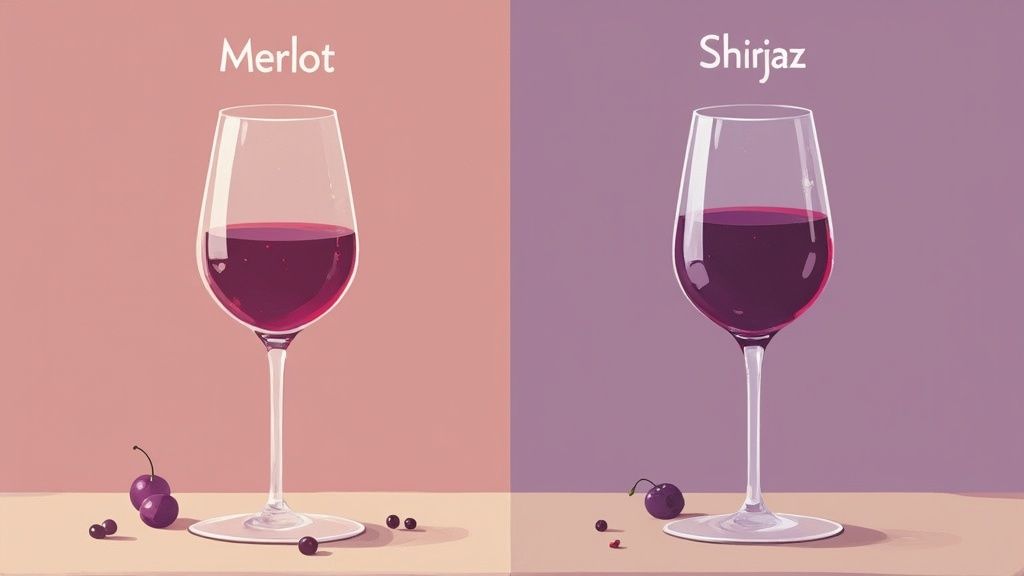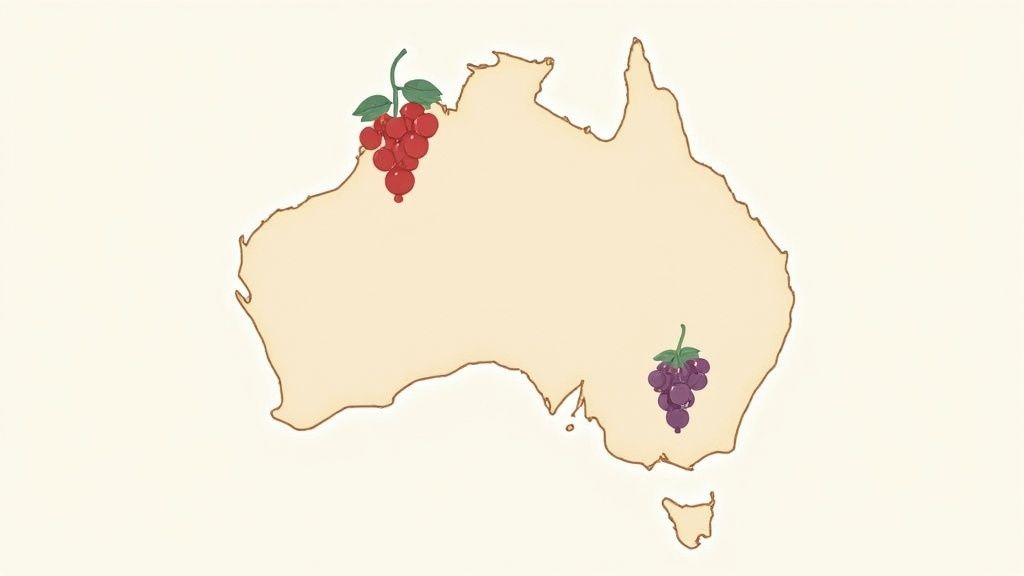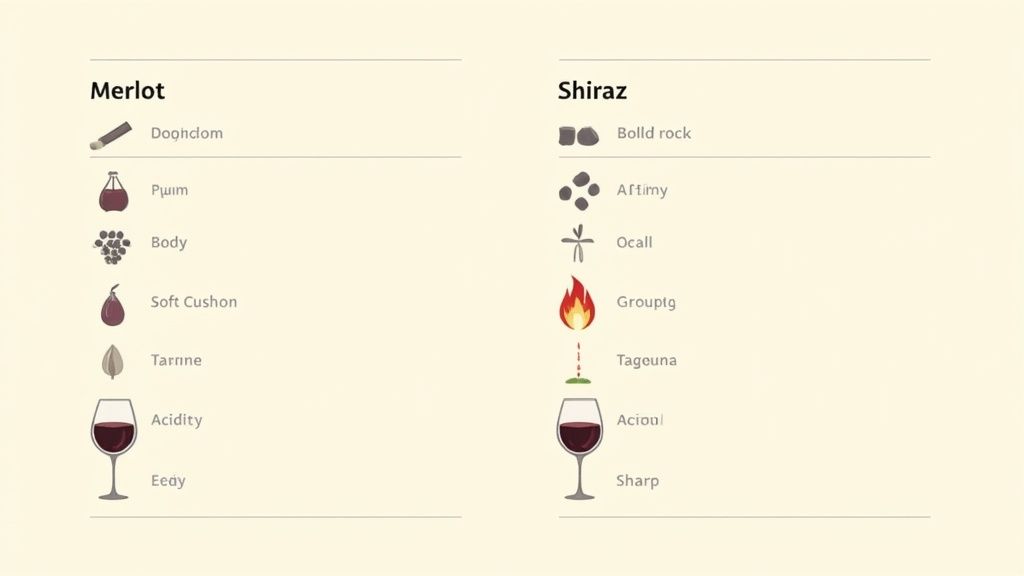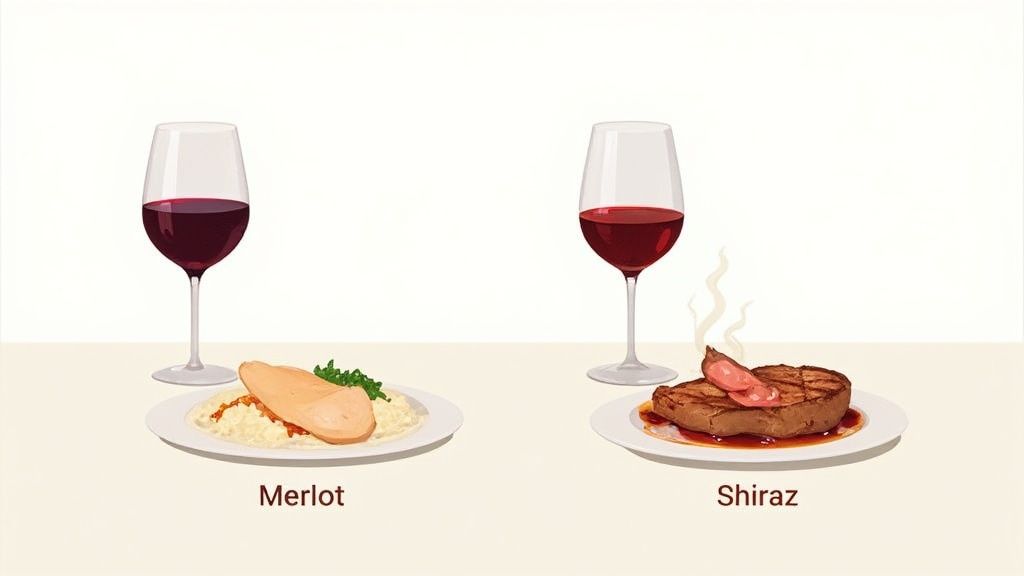When you're trying to settle the great Merlot vs Shiraz debate, it really comes down to personality. Think of Merlot as the smooth, approachable friend – it’s known for that velvety texture and crowd-pleasing notes of plum and black cherry. Shiraz is the bolder, spicier character in the room, delivering a much more robust, full-bodied experience with big flavours of dark blackberry, pepper, and sometimes a hint of smokiness.
Merlot vs Shiraz: An Immediate Comparison
To get a feel for these differences straight away, let’s break down their essential characteristics side-by-side. This is the foundational stuff you need to know before we dive deeper into where they come from, their flavour nuances, and what foods make them sing. Getting a handle on these key attributes is the first step in figuring out which red is right for your palate or your next meal.

This quick overview really sets the stage. While Merlot often gets pegged as the more elegant and subtle option, a powerful Australian Shiraz offers an intensity that many red wine lovers actively hunt for.
Merlot vs Shiraz At a Glance
The choice between these two globally popular reds often boils down to a personal preference for body and texture. Merlot’s plush, rounded mouthfeel makes it incredibly versatile, while the structured tannins and peppery spice of a good Shiraz demand your full attention.
To make things even clearer, here’s a simple table that lays it all out.
| Characteristic | Merlot | Shiraz (Syrah) |
|---|---|---|
| Primary Flavours | Black cherry, plum, raspberry, chocolate, cedar | Blackberry, blueberry, black pepper, smoke, bacon fat |
| Body | Medium to Full-Bodied | Full-Bodied |
| Tannin Level | Medium | Medium-High to High |
| Acidity Level | Medium | Medium-High |
| Alcohol Content | 13.5%–14.5% ABV | 14%–15%+ ABV |
| Texture | Smooth, velvety, rounded | Rich, structured, sometimes peppery |
| Serving Temp | 15-18°C | 16-18°C |
| Key Regions | Bordeaux (France), California, Australia, Chile | Rhône Valley (France), Barossa Valley (Australia), California |
Key Takeaway: Choose Merlot for a smooth, fruit-forward experience that is easy to pair with a wide variety of foods. Opt for Shiraz when you’re in the mood for a bold, complex, and spicy red that can stand up to rich, flavourful dishes.
Ultimately, this table is a great starting point. As we explore further, you'll see how factors like region and winemaking style can create exciting variations within each grape variety.
Exploring Each Grape's Australian Story
To really get to the heart of the Merlot vs Shiraz debate, you have to look past what’s in the glass and understand their completely different journeys. Both grapes carry a rich history that has shaped their character, especially here in Australia. While their stories both start in France, they take dramatically different turns once they hit Aussie soil.

These origins aren't just trivia; they’re the foundation of the flavours, textures, and even the reputations these wines hold today.
Merlot: A Story of French Elegance
Merlot’s heritage is sunk deep into the soils of Bordeaux, France. For centuries, it’s been the celebrated blending partner to Cabernet Sauvignon, loved for its ability to add softness, plush fruit, and that signature velvety texture. It's the key to creating some of the world's most acclaimed red wines, thriving in the clay-heavy soils of Bordeaux's Right Bank where it produces wines that are both approachable and capable of incredible complexity.
When Merlot landed in Australia, it found a new home but never quite hit the superstar status that Shiraz did. It has been planted strategically in warmer regions like the Riverland and Langhorne Creek, where growers focus on making reliable, fruit-forward styles perfect for a broad audience. Australian Merlot might not have the historical weight of its French parent, but it has carved out a solid niche as a smooth, easy-drinking red. You can dive deeper into its background in our detailed article on the origins of the Merlot wine grape.
Shiraz: The Rhône Rebel Turned Aussie Icon
Shiraz, or Syrah as it's known back in its native France, comes from the Northern Rhône Valley. There, it makes powerful, savoury, and peppery wines with a firm spine—think Hermitage and Côte-Rôtie. It’s a grape of intensity and character, historically less about softness and more about structure and spice.
But when this grape arrived in Australia back in the 1830s, something remarkable happened. It didn't just adapt; it completely transformed. The Aussie sun turned it into the bold, fruit-driven powerhouse we all know and love. This reinvention was so total that Shiraz is now, without a doubt, Australia's signature red grape, finding its spiritual home in places like the Barossa Valley and, of course, McLaren Vale.
Shiraz is more than just a popular grape in Australia; it is the backbone of the nation's red wine identity. Its journey from a respected French variety to an Australian icon is a testament to its incredible versatility and perfect suitability to our diverse terroirs.
The grape’s dominance isn't just a story we tell; the numbers back it up. Shiraz is by far Australia's most planted red grape, blowing Merlot out of the water and cementing its national importance. As of 2023, Shiraz accounted for roughly 46% of Australia's red grape plantings, a figure that dwarfs the global average of 7% for the variety. This makes Australia uniquely reliant on Shiraz in the global wine market.
Over the 15 years leading up to 2023, the average annual Shiraz crush was about 417,000 tonnes. It even hit a record high of 535,000 tonnes in 2021, as detailed in reports from Wine Australia.
A Detailed Breakdown of Flavour Profiles

This is where the real fun begins. Getting to know Merlot and Shiraz isn't just about a quick taste; it's about understanding the unique story each wine tells your senses.
To really get to the heart of what separates them, we need to look beyond simple tasting notes and break down the five core elements of any wine: aroma, body, tannin, acidity, and alcohol. Learning to spot these individual components is what turns a casual sipper into a confident taster.
It’s how you start to articulate exactly why you prefer one over the other.
- Aroma is what the wine smells like, offering the first clues to its character.
- Body describes the weight and feel of the wine in your mouth.
- Tannin gives the wine its structure and texture, that drying sensation on your gums.
- Acidity provides freshness and makes your mouth water.
- Alcohol contributes warmth and viscosity, felt at the back of your throat.
Aroma And Nose Profiles
Get your nose in the glass, and the differences start to become immediately clear. Merlot tends to greet you with a softer, more inviting bouquet of ripe plum and black cherry, often with a lovely hint of cocoa or even dried herbs.
Shiraz, on the other hand, is much more assertive. It jumps out of the glass with bold aromas of dark blackberry, a classic crack of black pepper, and often a smoky, earthy undertone. In a classic Aussie Shiraz, you might even find hints of blueberry and liquorice.
The aroma profile sets the stage for your palate, signalling either gentle roundness or bold spice.
These distinct scents give you a fantastic preview of how each wine is going to feel once you take a sip.
Body And Mouthfeel
When it comes to how the wine feels in your mouth, Merlot and Shiraz are worlds apart. Merlot usually sits in the medium to full-bodied range, feeling plush and velvety on the palate. Its tannins are typically soft and rounded, creating a smooth, almost cushiony texture.
Shiraz is almost always full-bodied, with a denser, more powerful presence. Especially in warmer climates like ours in Australia, it develops a rich, silky mouthfeel but with a much firmer structure underpinning it all.
- Merlot: Think silky flow and a gentle, comforting weight.
- Shiraz: Expect a richer density and a bold, commanding presence.
This contrast in texture is one of the most defining differences between the two. The table below gives a handy summary of how all the sensory elements stack up.
Detailed Sensory Profile Merlot vs Shiraz
This table offers a clear, side-by-side look at the typical sensory experience you can expect from a glass of Merlot compared to a glass of Shiraz.
| Sensory Element | Typical Merlot Profile | Typical Shiraz Profile |
|---|---|---|
| Aroma | Soft plum, black cherry, herbal hints | Bold blackberry, pepper, and smoky notes |
| Body | Medium to full, velvety texture | Full, dense, and structured |
| Tannin Structure | Rounded, medium grip | Firm, robust, and peppery |
| Acidity | Medium brightness | Medium-high lift |
| Alcohol Level | 13.5%–14.5% ABV | 14%–15%+ ABV |
With these core differences laid out, let's take a closer look at the elements that give these wines their structure and longevity: tannin and acidity.
Tannin Structure And Acidity
Tannins are responsible for that textural grip in a red wine. In Merlot, they are generally smooth and gentle, providing structure without being aggressive or overly drying. This makes it incredibly approachable, especially for those who are newer to red wines.
Shiraz, with its thick grape skins, packs a much bigger tannic punch. These tannins are firm and robust, often with a peppery quality that complements the wine's spicy notes. It's this strong backbone that gives Shiraz its excellent potential for ageing.
Acidity brings the freshness. Merlot typically has medium acidity, just enough to balance its plush fruit and keep it from feeling flabby. Shiraz, in contrast, often has medium-to-high acidity, which is crucial for cutting through its own richness and accentuating those signature spicy flavours.
Alcohol Levels And Finish
You can often feel the difference in alcohol between these two. Merlot usually clocks in between 13.5% and 14.5% ABV. It provides a gentle warmth that integrates well with the fruit.
Shiraz, especially from warmer regions, frequently pushes past 14% ABV, sometimes reaching 15% or more. This higher alcohol contributes to its fuller body and a distinct warming sensation on the finish.
The finish itself also differs. Merlot tends to fade gracefully with a soft echo of fruit, while Shiraz leaves a lasting impression, with a long, peppery persistence that lingers on the palate.
Want to dive deeper into Australia's signature red? Learn more about classic Shiraz wine in our article on What Is Shiraz Wine.
Bringing It All Together
With this sensory toolkit, choosing between Merlot and Shiraz becomes a much more intentional and enjoyable process. You can now pinpoint exactly what you’re looking for in a wine.
- Choose Merlot for a relaxed evening with a cheese board or roast chicken. Its velvety texture and gentle nature make it a versatile and crowd-pleasing option.
- Opt for Shiraz when you're firing up the barbecue or serving a hearty lamb roast. Its bold spice and full body are a perfect match for rich, flavourful dishes.
- For the cellar, a robust Shiraz is the clear choice. Its powerful structure of tannin and alcohol is built for the long haul, whereas Merlot is often ready to be enjoyed much sooner.
The best way to truly understand these differences is to taste them side-by-side. Pour a glass of each and take notes on every element we've discussed. You’ll be amazed at how quickly your palate learns to distinguish them with confidence.
How To Perfectly Pair Food With Merlot And Shiraz
At its heart, food and wine pairing is about harmony rather than hard-and-fast rules. You’re simply looking to match the weight and flavour intensity of the dish with the wine in your glass. Between Merlot and Shiraz, you’ve got two very different characters that shine when paired thoughtfully one plays the role of the peacemaker, the other demands a heavyweight match.

Merlot, known for its plush, fruity profile and soft tannins, glides across the palate without upstaging the food. On the other hand, Shiraz brings peppery spice and a robust body that calls for dishes with plenty of gusto. Grasping this contrast is the first step toward pouring with confidence.
Classic Pairings For Merlot
Merlot’s medium-bodied structure and notes of plum and black cherry make it incredibly versatile. It’s the go-to for laid-back dinners or that roast you’re cooking for friends.
Think of Merlot as a team player: it lifts the flavours of your cooking rather than clashing with them. Here are some combinations I’ve found rarely fail:
- Roast Chicken Or Turkey: The gentle fruit notes accentuate the herbs without swamping the meat’s natural juices.
- Pork Tenderloin: Especially when you glaze it with a plum or cherry sauce, Merlot’s round texture is a perfect match.
- Pasta With Tomato-Based Sauces: Its moderate acidity keeps things lively alongside a rich marinara or bolognese.
- Mushroom Risotto: Earthy mushrooms find a soulmate in Merlot’s savoury undertones.
When in doubt, reach for Merlot. Its balanced profile and smooth finish can partner with everything from pizza nights to a full Sunday roast.
Bold Pairings For Shiraz
Shiraz doesn’t ask for permission; it demands a stage. With its full body, dark fruit concentration, and firm tannins, you need dishes that pack a punch.
This is your barbecue star think charred flavours, rich sauces, and a bit of smoke. Give it weighty fare and it will shine.
- Grilled And Barbecued Meats: Shiraz stands up to smoky ribs, sausages, and chargrilled steak with ease.
- Slow-Cooked Lamb Shanks: The wine’s spice cuts through the fat while complementing the herb rub.
- Spicy Dishes: Whether it’s a peppery curry or a fiery stir-fry, a fruit-forward Shiraz can handle the heat.
- Hard, Aged Cheeses: A mature Shiraz will stand toe-to-toe with aged cheddar or parmesan.
Pairing With Vegetarian Dishes And Cheeses
Don’t think vegetarian cuisine is off the table. Merlot’s subtle earthiness works beautifully with root veg, lentil shepherd’s pie, or grilled eggplant.
Shiraz, with that peppery kick, pairs brilliantly with black bean burgers, smoky jackfruit, or any veg dish with bold spices.
- For Merlot: Semi-hard cheeses like Gouda, Gruyère, or mild cheddar lean into its soft fruit.
- For Shiraz: Pick a bold cheddar, salty Pecorino, or smoked Gouda to stand up to its intensity.
When you’re hosting, you might even choose to create a sophisticated grazing table with a mix of these foods. It lets everyone taste how each wine interacts with different flavours.
Making the Right Choice for Any Occasion
Figuring out whether to grab a Merlot or a Shiraz isn’t just about personal taste it’s about the context. The perfect bottle often depends on the meal, the mood, and who you're sharing it with. Think of it like casting a role in a play: each wine is perfectly suited for a different scene.
Merlot is your go-to when the situation calls for a bit of diplomacy. Its smooth, fruit-forward profile and soft tannins make it a fantastic crowd-pleaser, especially if you’re hosting guests with different wine preferences. It’s the safe, yet always sophisticated, choice for a family dinner or a relaxed catch up with mates.
Shiraz, on the other hand, is for making a statement. Its bold spice, full body, and powerful structure are made for occasions where the wine itself is a centrepiece. Pouring a cracking Barossa Shiraz for a fellow wine lover or pairing it with a rich, celebratory feast shows you mean business.
Situational Buying Guide
Let’s break it down with a few common scenarios to make your next trip to the bottle shop a breeze. The goal is simple: match the wine's personality to the vibe of the event.
- The Weeknight Dinner: You’re after something reliable that won’t overwhelm a simple meal like pasta or a roast chook. Merlot is the clear winner here. It’s versatile and just plain easy to drink.
- The Winter Barbecue: When you’ve got grilled meats, smoky flavours, and rich marinades on the go, you need a wine that can hold its own. A classic Australian Shiraz is really the only way to go.
- The Dinner Party with Mixed Palates: Not sure what everyone likes? A soft, approachable Merlot is far less likely to polarise than a big, peppery Shiraz. It’s the perfect bridge between white wine drinkers and serious red enthusiasts.
- The Wine-Lover's Gathering: To impress someone who knows their stuff, a complex, top-quality Shiraz from a renowned region like McLaren Vale or the Barossa offers layers of flavour to unpack and chat about.
Decision Point: For harmony and approachability, choose Merlot. For boldness and a memorable flavour experience, choose Shiraz. In the Merlot vs Shiraz debate, the best choice is always the one that fits the moment.
Ageing Potential And Cellaring
Both wines can age beautifully, but they take different paths. A high quality Merlot, especially from a cooler climate, can develop gorgeous earthy and tobacco notes over five to ten years as its tannins soften into pure velvet.
Shiraz, with its higher tannin and acidity, is often built for the long haul. A premium Australian Shiraz can easily evolve for a decade or more. Over time, its powerful fruit mellows out, revealing complex savoury notes of leather, spice, and smoked meat.
While Shiraz is Australia's undisputed red king, Merlot still holds its own. Merlot grapes cover around 6.3% of Australia’s vineyard area, with major plantings in the Riverland (22%) and Riverina (18%). The Merlot grape crush in a recent representative year was about 111,000 tonnes roughly 8% of the total national crush, proving it remains a significant player in our wine scene. You can find more facts about Australian Merlot from JustWines.com.au.
Ultimately, a good cellar benefits from having both. A well made Merlot offers a fantastic medium-term reward, while a top-tier Shiraz is an investment in future enjoyment. Understanding these timelines helps you buy with purpose, whether you plan to drink it tonight or cellar it for a special occasion down the road.
How Australian Regions Define the Wines
When you're weighing up Merlot versus Shiraz, Australia's incredibly diverse landscape is the real decider. The whole concept of terroir that magic blend of soil, climate, and geography is what steers a grape towards becoming a big, bold red or something more subtle and restrained. It’s exactly why a Shiraz from one place can taste worlds apart from another, and why some spots are just better suited to Merlot’s softer side.
You see this most clearly with Shiraz. Grab a bottle from the warm, sun-drenched Barossa Valley, and you’re in for a powerful, rich experience, practically bursting with blackberry, dark chocolate, and mocha. But a Shiraz from a cooler area, like the Adelaide Hills or parts of Victoria, will be a different beast entirely think more raspberry, savoury notes, and that classic peppery spice. To really get into these nuances, check out our guide to Australia's premier Shiraz regions.
Climate's Impact on Style
Merlot is just as sensitive to its surroundings. In warmer inland regions like the Riverland, it gives you soft, easy drinking wines with generous plum and fruitcake notes perfect for a casual weeknight.
But plant that same grape in the cooler, maritime climate of a region like Coonawarra, with its famous red terra rossa soil, and Merlot completely changes its tune. It becomes more structured and elegant, showing off refined tannins and complex flavours of black cherry, cedar, and dried herbs. It’s a real nod to its Bordeaux heritage.
Key Insight: As a rule of thumb, a warm climate brings out riper, bolder fruit and higher alcohol in both Merlot and Shiraz. Cooler climates push the style towards higher acidity, more delicate fruit, and savoury or spicy characters.
Production Trends and Market Shifts
Beyond the vineyard, what's happening in the wider industry also shapes what ends up on the shelf. Australian wine production can be a rollercoaster, with the weather calling most of the shots. Between 2014 and 2024, the industry hit some major hurdles, with tough conditions affecting the yields for both Shiraz and Merlot.
Take the 2023 vintage, for instance. The grape crush was 1.32 million tonnes, a whopping 26% below the ten-year average. The good news is that forecasts for the 2025 vintage are looking up, with red grape tonnage expected to climb by 20% compared to 2024. These swings can mess with availability and price, so it pays to keep an eye on how each vintage is shaping up. For more data, you can dig into Australian wine production trends at Statista.
Got Questions About Merlot and Shiraz?
Let's wrap things up by tackling a few of the most common questions we hear. Think of this as a quick guide to clear up any lingering doubts before you head to the bottle shop or browse a wine list.
Is Merlot a Sweeter Wine Than Shiraz?
This is a great question, and the short answer is no neither wine is technically sweet. Both Merlot and Shiraz are almost always fermented to be dry, which means the natural grape sugars are converted into alcohol.
What you're picking up on is the impression of sweetness. Merlot’s naturally plush, ripe fruit flavours think juicy plums and cherries and its softer tannins can feel smooth and almost sweet on the palate. It's a fruit-driven richness.
Shiraz, especially a classic Aussie style, is just as fruit-packed, but it comes with a bold spicy or peppery kick, stronger tannins, and often a bit more acidity. That combination gives it a more savoury finish. So, while Merlot's fruitiness can be mistaken for sweetness, the spice in Shiraz tends to stand out more.
Which Wine Is Better for a Beginner?
For anyone just dipping their toes into the world of red wine, Merlot is often the perfect starting point. Its profile is incredibly approachable, with soft tannins and a rounded, smooth body that won't feel harsh or overly astringent to a new palate.
That said, you can certainly find plenty of friendly, medium-bodied Australian Shiraz styles that are bursting with fruit and easy to enjoy. But if you're looking for a reliably smooth and gentle introduction, a good Merlot is probably your safest bet.
For new drinkers, the key difference is texture. Merlot often feels "velvety" and glides across the palate, making it an easy first step. Shiraz offers more structure and a peppery character that might be best explored once you're comfortable with softer reds.
Can I Use Shiraz Instead of Merlot in a Recipe?
Absolutely, but you need to know what you're getting into. When a recipe calls for Merlot, it's usually looking for those soft, plummy notes to create a rich, smooth base for a sauce, like in a beef bourguignon.
Swapping in a big, peppery Australian Shiraz will bring a lot more spice and intensity to the party. That could be fantastic in a hearty, robust stew or a sticky barbecue glaze, but it might just overwhelm a more delicate dish.
If you do make the swap:
- Try to find a more restrained, medium-bodied Shiraz if possible.
- It's a good idea to add the wine to your dish a little at a time, tasting as you go to make sure it doesn't overpower everything else.
Ready to explore the best of McLaren Vale? At McLaren Vale Cellars, we've curated an exceptional selection of both iconic Shiraz and elegant Merlot from our region's finest producers. Discover your next favourite bottle today.




Comments (0)
There are no comments for this article. Be the first one to leave a message!